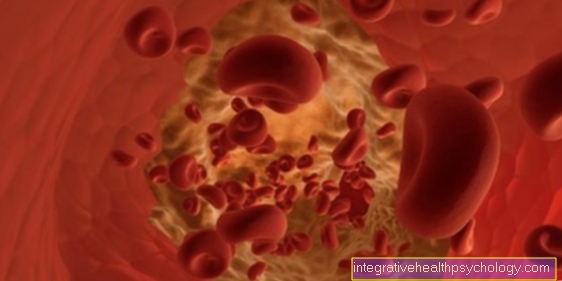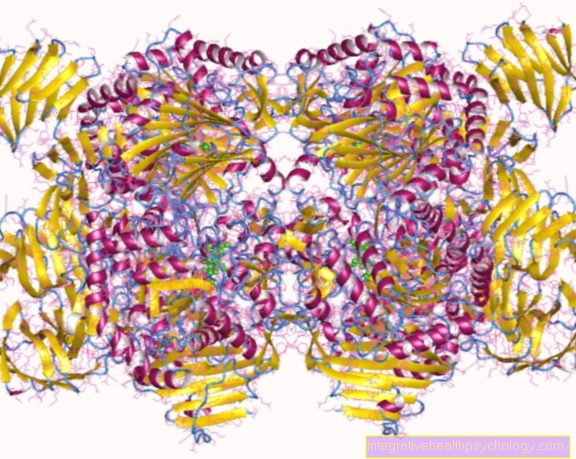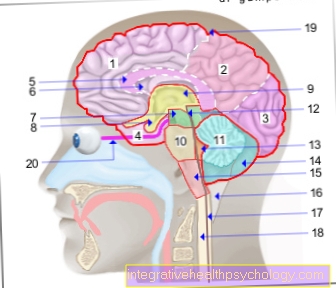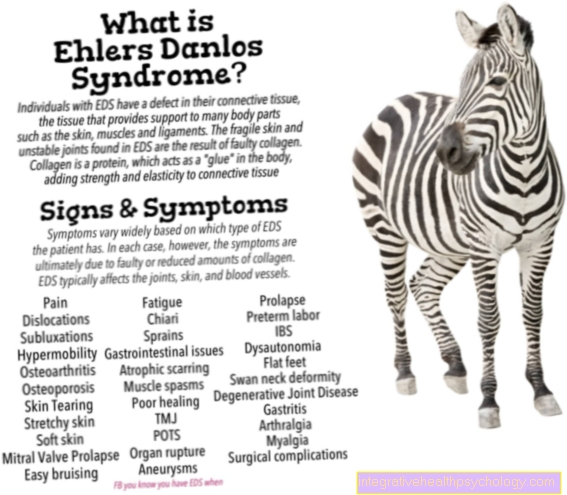Extended mark
Synonyms
Medulla oblongata, Bulbus medullae spinalis
definition
The medulla oblongata is part of the central nervous system (CNS). She is the furthest down (caudal) located part of the brain. The medulla oblongata, together with the bridge (Pons) and the midbrain (Mesencephalon) to the brain stem (Truncus cerebri) counted.
The elongated marrow contains nerve nuclei and pathways that control vital processes, such as breathing, and some of the 12 cranial nerves also run here.
anatomy

The medulla oblongata closes upwards (cranial) to the spinal cord. It begins at the exit of the first spinal nerve. Further cranially it borders on the bridge (Pons). It is therefore the lowest part of the brain from an anatomical point of view.
Together with the bridge and the cerebellum, it belongs to the hindbrain (rhombencephalon). Anatomically, it is divided into three parts: the tegmentum (hood), the pyramids and the olives or olive pits.
The tegmentum lies behind (dorsal) and is the place of origin of numerous nerve cells, i.e. nerve core areas are located here.
The pyramids lie on both sides of the midline on the front of the medulla oblongata. They are the part of the medulla oblongata in which the pyramidal path runs along. The orbit of the pyramid is responsible for much of the arbitrary movement. A lesion of the pyramidal tract leads to paralysis in the affected area of the body. In the lower part of the pyramids, about 80% of the pyramidal path crosses from one side to the other. This means that the pathways from the right hemisphere cross to the left side of the body and those of the left hemisphere cross to the right side of the body. This is the reason why, in the case of a stroke in the area of the right half of the brain, the mobility of the left half of the body is often significantly restricted; this is called hemiparesis.
The olives are bulges on both sides a little to the side of the pyramids. They in turn contain nerve cell nuclei.
Illustration brain

Cerebrum (1st - 6th) = endbrain -
Telencephalon (Cerembrum)
- Frontal lobe - Frontal lobe
- Parietal lobe - Parietal lobe
- Occipital lobe -
Occipital lobe - Temporal lobe -
Temporal lobe - Bar - Corpus callosum
- Lateral ventricle -
Lateral ventricle - Midbrain - Mesencephalon
Diencephalon (8th and 9th) -
Diencephalon - Pituitary gland - Hypophysis
- Third ventricle -
Ventriculus tertius - Bridge - Pons
- Cerebellum - Cerebellum
- Midbrain aquifer -
Aqueductus mesencephali - Fourth ventricle - Ventriculus quartus
- Cerebellar hemisphere - Hemispherium cerebelli
- Elongated Mark -
Myelencephalon (Medulla oblongata) - Big cistern -
Cisterna cerebellomedullaris posterior - Central canal (of the spinal cord) -
Central canal - Spinal cord - Medulla spinalis
- External cerebral water space -
Subarachnoid space
(leptomeningeum) - Optic nerve - Optic nerve
Forebrain (Prosencephalon)
= Cerebrum + diencephalon
(1.-6. + 8.-9.)
Hindbrain (Metencephalon)
= Bridge + cerebellum (10th + 11th)
Hindbrain (Rhombencephalon)
= Bridge + cerebellum + elongated medulla
(10. + 11. + 15)
Brain stem (Truncus encephali)
= Midbrain + bridge + elongated medulla
(7. + 10. + 15.)
You can find an overview of all Dr-Gumpert images at: medical illustrations
Meaning / function
In the medulla oblongata there are control centers for Cycle and breathing. This means that they play a very central role in controlling the "basal“Body functions play a role. A permanent failure of the medulla oblongata cannot be survived.
Furthermore, the medulla contains reflex centers for Reflexes like sneezing, coughing, and swallowing. That too Vomiting center is located in the medulla, it is in the area postrema. Numerous nerve cell nuclei are located in the dorsal area of the medulla oblongata, the tegmentum. For example, the couple Nucleus cuneatus and Gracilis nucleuswhich each cause two protrusions of the same name in the area of the tegmentum (tuberculum gracilis and cuneatum). This is where nerve pathways are used for the perception of the Surface sensitivity switched on arms (nucleus cuneatus) and legs (nucleus gracilis). These are called Hinterstrangbahn designated. Light touches on the arms or legs can only be adequately passed on if the posterior pulmonary tract and the core areas are intact.
The two Olive pits contain, as the name suggests, also core areas. On the one hand, this is the upper olive stone (Nucleus olivaris superior) and on the other hand the lower olive stone (Nucleus olivaris inferior). The upper olive core is an important part of the auditory pathway, it releases fibers, among other things Cochlea (Cochlea). The lower olive stone is involved in the coordination of voluntary movements, among other things it releases fibers to the Cerebellum (Cerebellum). To list all other core areas that have their seat in the medulla oblongata would go beyond the scope here, so the article is limited to the examples mentioned.
In the extended marrow 4 of the 12 paired occur Cranial nerves out. Between the olive and the tuberculum cuneatum of the Glossopharyngeal nervewhich is responsible for innervating part of the throat muscles, the taste of the back of the tongue, and sensitivity in part of the throat, among other things.
The tenth cranial nerve, the Vagus nerve, emerges from the side of the olive. He is responsible for many things. For example, for part of the muscles of the larynx and pharynx, for the regulation of the internal organs and for the sensitivity in parts of the pharynx and ear canal.
Also the eleventh cranial nerve, the Accessory nerve, emerges from the side of the olive. It leads purely motor fibers for the innervation of the Sternocleidomastoid muscle, part of the neck muscles and the Trapezius muscle, part of the back / neck muscles. The twelfth and last cranial nerve, the Hypoglossal nerve emerges between pyramids and olives. It is essential for the mobility of the tongue.
Clinical evidence
A disorder of the medulla oblongata occurs, for example, in patients with a so-called Bulbar paralysis. This affects the cranial nerves running in the medulla. These have the innervation of the Throat and pharynx muscles common. Accordingly, this clinical picture leads to partial paralysis of the muscles of tongue, Larynx, Swallower and Masticatory muscles, the patients fail Sip- and Speech disorders sometimes they also suffer from breathing difficulties.
Clinical signs of bulbar paralysis are one atrophy and Fasciculations (small trembling movements) of the tongue. The bulbar paralysis can be isolated but also as an accompanying symptom in the context of a Amyotrophic lateral sclerosis (ALS) occur.
The area postrema, also known colloquially as the “vomiting center”, plays an important role in cancer patients who are treated with chemotherapy drugs. These often cause severe nausea. For this reason, attempts are made in these patients to work with drugs that inhibit the activity of the area postrema and thus the feeling of nausea and nausea as well as vomiting.





























